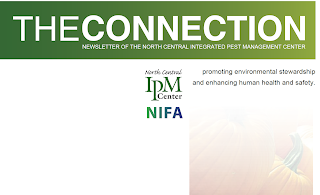
Yesterday Clyde, Pierce, Barb, Gina from the Lancaster County Health Department (who works with training child care providers on health and safety), and I went to do an IPM assessment at the first of three child care centers in Lincoln. This one was the largest of the three, with several classrooms, its own commercial kitchen, a "mom's room,", laundry room, large indoor and outdoor recess areas, and two staff breakrooms. The facility is new construction, only two years old and is being kept in excellent condition.
The director and assistant direct accompanied us on our tour. They reported very few pest problems. They said when the facility was being built and doors were being left open, they had a few mice, but hadn't since. Some mouse traps were still left out, but some of these were being used to catch insects (sticky traps were being placed inside). Ground beetles and "fruit flies" were the only other complaint.
Upon checking all the rooms, we noted that the staff is doing very well overall on keeping the facility in good condition.

For example, the kitchen's cook has been doing an excellent job with maintaining sanitation, especially in cleaning floor drains to prevent buildup that can attract flies and cockroaches. She noted that she'd seen a few fruit flies by the drain, but regularly cleans the drains to try to reduce problems. We also noted that all permanent food prep areas/sinks/fixtures were sealed at the wall junction. The storage closet has open shelves and no wooden pallets, both things we encourage in kitchen storage areas to prevent pests. These are all great IPM approaches!
The classrooms had some clutter and some had small kitchens, but overall were in good shape. One had a pet guinea pig that appeared well cared for. Generally floors were clean throughout the facility, with just a few areas, such as in the laundry room, that could use better sanitation. We also found a rodent ultrasound device that we informed the staff wasn't effective in deterring pests.
We are going to provide general recommendations for this child care center, such as caulking around escutcheon plates on the sinks in the bathrooms, keeping food in a centralized location and in pest proof containers, good sanitation, and reducing clutter. We also noticed mulch and vegetation close to the building around the perimeter, which may be the source of the ground beetles. The facility may want to address this to reduce the number of beetles that come into the building.

Although this child care center has had no problems with bed bugs, we did give them some pointers about what to do in case a problem would ever occur. We advised them to keep a close eye on coat rack areas where children's coats and backpacks might be stored, and the pet cage, since bed bugs would be attracted to the guinea pig at night when people are not around. Since the facility has an onsite laundry room, we recommended drying clothing or backpacks at 120 degrees if bed bugs are suspected. Bed bugs are vulnerable to heat and succumb to it fairly easily.
Overall this was a well maintained child care center that seemed very interested in learning about and implementing IPM strategies to keep pests out or get rid of any that might become a problem. In addition, their pest control technician also seems to be on board--he does not come in and automatically spray but instead recommends IPM approaches. Just what we like to hear!













